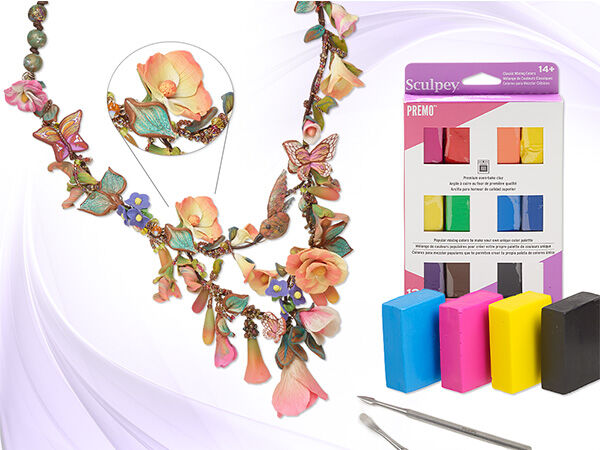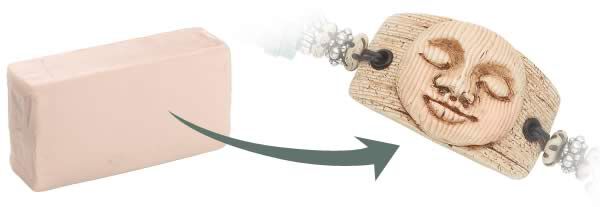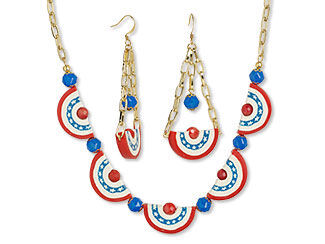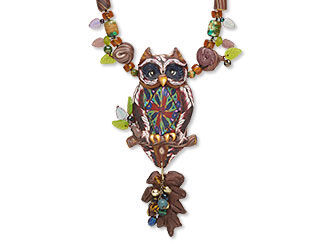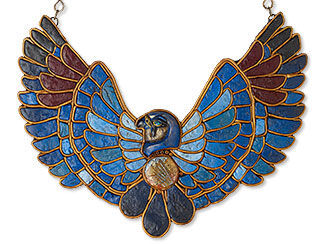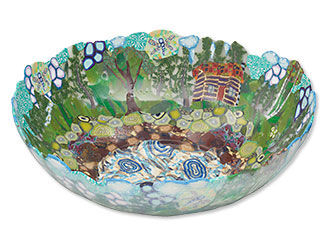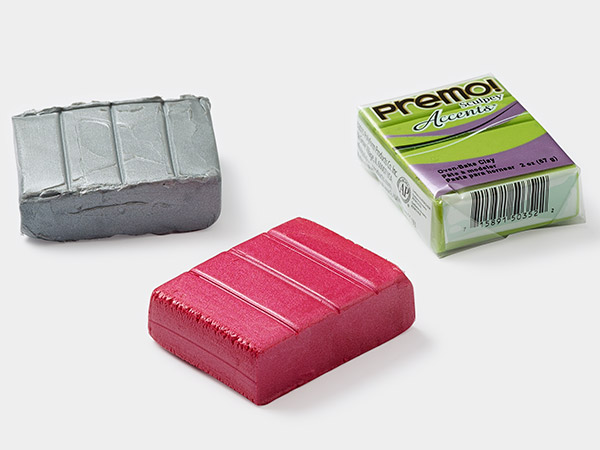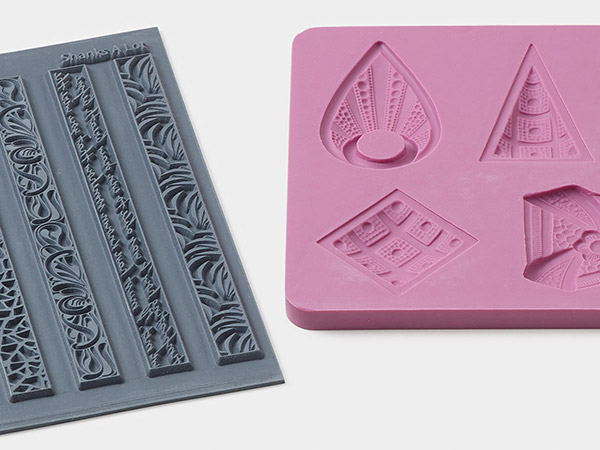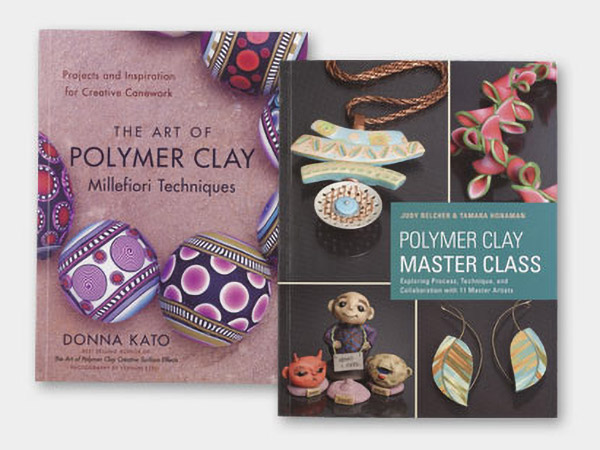What is Polymer Clay?
by Tammy Honaman, Author, Jewelry-Making Expert and Educator
and Elaine Young, Jewelry Designer and Polymer Clay Artist
Exclusively for Fire Mountain Gems and Beads®
By Marilynn Ordonez, Design Idea MH49
Polymer clay is a clay-like material made from polyvinyl chloride (PVC) that contains plasticizer and pigments . It is available in many colors and brands, with each brand offering its own color palette and properties.
Polymer clay is an amazing art material that, like modelling clay, can be molded , shaped, stamped, layered, extruded and turned into almost anything! Once fully baked (cured) and hardened, the clay can be further enhanced by sanding and buffing, drilling and sealing your piece . You can also carve, cut and sew the clay once cured. The possibilities are endless.
Polymer Clay Baking and Safety
Polymer clay itself is non-toxic, making it an ideal medium for people of all ages, and has very few limitations. For any technique you choose to explore , the clay must be cured to capture your creativity. Curing your piece requires it to be baked in an oven or toaster oven . However, there are a few rules you need to understand before you begin. These rules help to ensure your safety and of those around you:
- You must condition the clay before you begin working with it. Conditioning not only makes the clay easier to work with, it also gives it strength and stability.
- When using your home oven, it is suggested to cover your piece properly. If you use a toaster oven, use that as your dedicated crafting appliance.
- You must dedicate any of your "kitchen" tools (pasta maker and anything else you would normally use for food) and baking surface (cookie sheet or ceramic tile) you use on polymer clay solely for that purpose. This will keep residue from the clay away from your food.
- The clay should not be ingested, so make it a rule to not eat food while working with the clay. Not only will this keep you from accidentally eating the clay, but it will also keep you from getting any crumbs into your creations!
- Polymer clay must never be baked in a microwave or under a broiler and should only be baked at the manufacturer's recommended temperature and timing instructions. However, depending on the size of your piece, start at a lower time and go up from there.
- If you accidentally bake the clay at a higher temperature and cause the clay to burn or catch on fire, extinguish any flames with a fire extinguisher, turn off the oven, open the windows and leave the room until the noxious fumes have dissipated.
Great Polymer Clay Starter Tools
When you’re ready to start playing with polymer clay, you can use these easy tools, some of which are found right in your household:
- Craft Knife/X-acto Knife
- Acrylic or Plastic Roller
- Dotting/Ball Tools
- Scraper Blades (razor)
- Ceramic Tiles from hardware store
- Basic Cutters/Shapes
- Extruder
- Toothbrush
- Toothpicks
- Baby Wipes/ Paper Towels (for clean hands & tools)
Polymer Clay Myths
“It’s OK to add oil to soften hard clay.”
It is normal for polymer clay to get a little hard if not properly sealed after use. To soften the clay, run through a dedicated pasta machine. This will loosen up your clay again to be pliable. Adding mineral oil, baby oil or petroleum jelly will make the clay softer, but after baking can make your piece look odd, shiny, and can even weep the oils back out. The better recommendation for achieving more softness is to use a clay conditioner.
“I can use Acetone to remove any flaws.”
Acetone is an aggressive solvent that dissolves clay, both baked and unbaked. That said, you can use it to salvage pieces that have lint or particles baked into them, but you’ll be ruining your piece if you use too much. A gentler method is to use rubbing alcohol to remove lint and small marks BEFORE baking. Having a clean work area and keeping your hands and tools clean is also a good practice to have and will prevent things from sticking to or flawing your pieces.
“One brand of clay is better than the other.”
It is all about the personal preference of the artist or user and what they are making. They are all a bit different in terms of handling, color range, interaction with other materials and how fine your detail work is. One person will find one brand their favorite, while the same brand is another’s least favorite. Some brands are better for blending, others work best for caning, and so on. Again, it’s all personal preference.
“Polymer clay is just a kids' toy.”
Many well-known artists have been using polymer clay for years in their artwork. It's one of the best media for exploring use of colors. Unlike paint, you can use polymer clay as a 3-dimensional view to expand your imagination and creativity. You can find everything made from polymer clay, from fine art to exquisite jewelry pieces!
“Baking polymer clay more than once will ruin your piece.”
It is fine to bake polymer clay over and over again. Just beware of getting it too hot and burning your piece or becoming too dark. A lot of pieces that have layers have been baked several times.
“Translucent polymer clay should be clear.”
Know the difference between “translucent” and “transparent (clear).” Translucent means that light will come through your piece, but not clear to see through. And watch your oven's temperature. If not correct, this will create browning, which will ruin the effect.
Popular Polymer Clay Techniques
Caning
A cane is a polymer clay log made with a design that runs the entire length of the log. Then slices are cut from the log to create designs, like slice-and-bake cookies. You can reduce the cane by compressing and squeezing to make the design or image smaller. It is sometimes misconstrued that caning is called “millefiori,” which means “thousand flowers,” borrowed from Italian glass working. Millefiori is actually the act of taking many slices and arranging them into a floral pattern, usually within a background . See how-to videos on various caning techniques led by industry experts:
- ''Quick and Simple Polymer Clay Cane Leaves''
- ''Jelly Roll Jewelry''
- ''How to Create a Bullseye Cane Using Polymer Clay''
- ''How to Create a Zipper Cane Using Polymer Clay''
- ''Millefiori Jelly Roll Caning''
Sculpting
Polymer clay is a great media for sculpting and molding. The original polymer clay was invented in the 1930s and was used primarily for sculpting dolls. All clays on the market today are still ideal for this purpose. You can use clay sculpting tools, dotting tools and cutters for shaping and adding detail to your designs . Household items such as toothbrushes, toothpicks, straws, foil and even sponges are great for texturing.
Image Transfers
You can transfer images onto polymer , preserving them and utilizing them in ways not possible before. Images that can be transferred include photos, drawings, photocopies (made with a copier that uses toner rather than ink) and screen stencils.
Faux Techniques, Embellishments and Other Finishing Touches
Polymer clay is a very versatile material that can be used to create faux stones, such as turquoise, jade and other opaque stones, or to resemble materials no longer available for use, such as ivory. It can also be used to mimic dichroic glass or mokume gane, an ancient Japanese metalworking technique. Polymer clay can even be made to look like wood, metal, fabric or yarn!
In addition to creating fun effects and textures with the clay itself, you can add finishes, glazes (available in glossy or matte to suit the "feel" of your piece) and other embellishments for even more artistic outlets. Brush on mica powders prior to baking for subtle shimmer and shine. Add details, highlights and more with chalk pastelsor sprinkle your creation with glitter for whimsical sparkle. Prior to baking, you can embed rhinestones (flat-backs or chatons; either is gorgeous) beads or cabochons of glass, baked polymer clay or certain gemstones (just be sure to research which stones can handle the heat).
Are you inspired to play with clay?
For more information on polymer clay, including how to create new colors with blending or how to even pick the best clay for you from the various brands, visit the Polymer Clay Resource Center at Fire Mountain Gems.
Have a question regarding this project? Email Customer Service.
Copyright Permissions
All works of authorship (articles, videos, tutorials and other creative works) are from the Fire Mountain Gems and Beads® Collection, and permission to copy is granted for non-commercial educational purposes only. All other reproduction requires written permission. For more information, please email copyrightpermission@firemtn.com.
